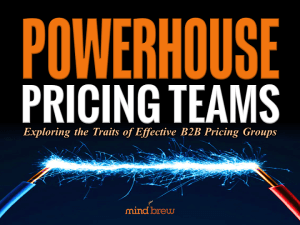Can you do your job proficiently with just business intelligence tools? BI and enterprise resource planning (ERP) tools can be beneficial to your organization in many ways:
- They offer summary reporting on key metrics over time and comparing periods
- Better BI implementations also support analysis on key attributes, such as customer or product segments and features
- Good ERP reporting and BI data visualization can answer many high level questions, such as sales & profit trends, budget to actual performance
Unfortunately, this information tends to be macro oriented, making it challenging to analyze and understand what is driving those high level statistics. Your tools might report the company lost half a point of margin last month or gained two points in revenue, but the details behind what is driving those changes often remains a mystery.
This is where BI and ERP tools fall short, particularly in the world of pricing management. To truly drive change—and therefore profit—you need logic and statistics applied to the lowest level transaction detail in order to take action and move beyond that rolled up view.
Some companies have experienced a level of success at segmenting their data so the pricing team or the product team can find clues as to “why.” However, it’s rare a business can get its data segmented in a proper way—down at the transaction level—where the person responsible for driving revenue, profit and volume can look at specific attributes across products, customers and orders in a way that can properly segment and index results to compare apples-to-apples.
Details Missed by BI Tools
While BI and ERP tools are capable of providing configurable and flexible graphs and tables with strong “filtering” capabilities, it is typically left to the user to “dig” through these filters to find root causes to summary level concerns. This requires an extensive use of an analyst’s time and often misses key causational factors given the thousands of customer/product transactions that could be driving the issue or opportunity.
Here’s a deeper look at these causational factors:
Example 1: Your current reporting tool reveals the company lost a half a percentage of margin last month, but does not expose the why. Here’s a breakdown of what you are missing:
- Your northern territory sales rep was over discounting
- A large number of orders were fulfilled leaking profit due to missed freight billing
- Your product mix was adjusted from last period to this period and more lower margin products were sold over your higher margin products
- Average net sales price for new orders is dragging down margin from existing business
- Finally, the costs of chrome plating have been creeping up undetected by your organization, so your cost on certain product lines has been steadily moving ahead of the price you are charging
Example 2: Client A has traditionally ordered in a fairly predictable pattern—a certain quantity month after month. But because your reporting tools do not have the sophisticated statistics to unearth order pattern changes that can be subtle or difficult to track due to seasonality, you don’t notice the client’s orders have shown significant drop off, making it difficult to detect and prevent churn. It is expensive to lose a customer, but if you are only using summary reporting, you probably won’t detect the problem until it is too late.
Example 3: You may be missing out on market basket analysis to unearth potential cross selling and wallet share opportunities since you are unable to compare and contrast similar customer orders. If Client X and Client Y are similar, but Client X has a much higher percentage of certain purchases, you could potentially drive more volume by approaching Client Y with similar upsells to Client X. Again, this kind of analysis involves extensive business logic and statistics to properly compare like peer groups and buying behavior, not just pretty graphs and charts.
Example 4: Your BI tool may give you information about winning or losing business, but it can’t identify key value drivers and key peer groups your sales rep can quote to win business. Your sales team is lacking the confidence it needs to ensure you will get the right price for products down to the lowest customer/product/order level in order to drive optimal margin for the company.
The Bottom Line
You can’t manage what you can’t measure. If you don’t have the type of business logic and statistical work that can help you identify these causational elements, how can you take action?
These elements can only be identified in their entirety with a pricing and profit application that easily provides you with alerts, scorecards and metrics that allow you to take action to maximize your revenue and drive profitability.













